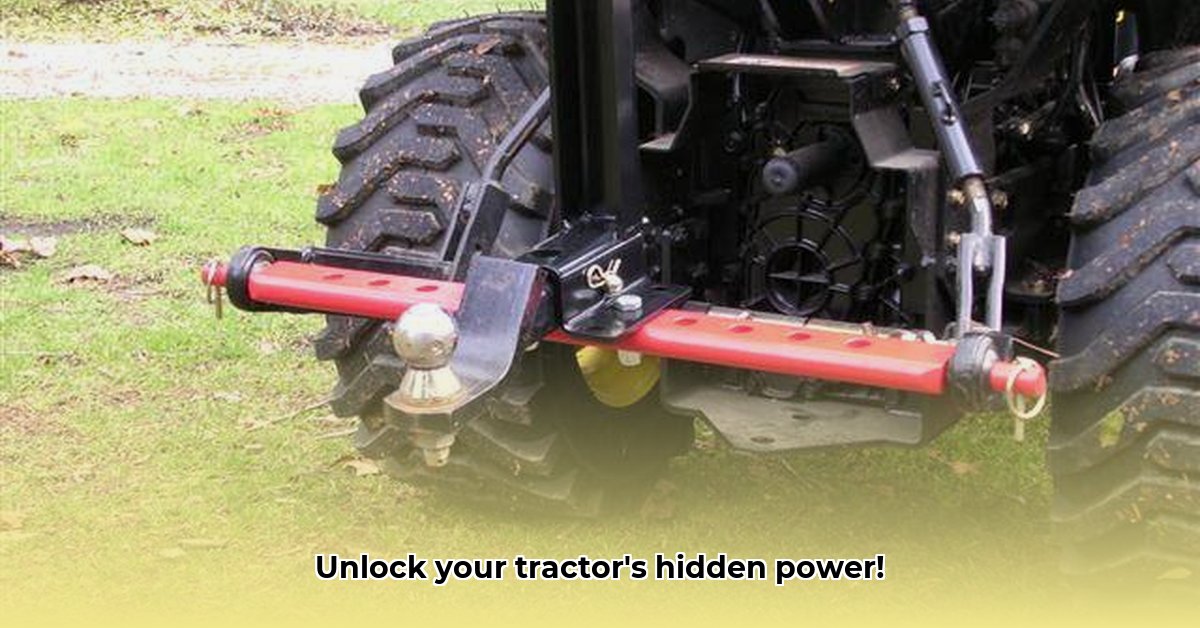
Understanding Your Tractor's Drawbar: The Unsung Hero
Your tractor's drawbar—that often-overlooked metal bar—is the crucial link between your tractor and all its implements. It's the key to efficient farming, impacting everything from fuel consumption to soil health. A well-maintained drawbar ensures smooth operations, efficient work, and reduced downtime. Think of it as the backbone of your field operations. This guide provides actionable steps to master your drawbar for increased efficiency and sustainability. For more in-depth information, check out this helpful resource on tractor drawbars.
Types of Tractor Drawbars: Choosing the Right Tool
Several drawbar types cater to specific needs. Understanding these differences is paramount for optimal performance and safety.
Fixed Drawbars: These simple, permanently attached drawbars are ideal for straightforward tasks where adjustability isn't essential. They’re reliable and cost-effective.
Adjustable Drawbars: Offering greater versatility, these allow height and angle adjustments for optimal implement positioning, crucial for tasks like plowing on uneven terrain.
Category 1 and 2 Hitches: Standardized systems ensuring compatibility between tractors and implements, offering simplicity and easy interchangeability. These are the universal connectors in the farming world.
Choosing the right drawbar depends on your specific needs and the implements you'll be using. Consider the weight of your implements, terrain variability, and your budget when making your selection.
Selecting the Right Drawbar: A Step-by-Step Guide
Selecting a drawbar isn't just about picking one from a catalog. Safety and efficiency are paramount. Follow these steps for optimal results:
Assess Implement Weight: Always check the manufacturer's specifications for your heaviest implement. The drawbar's weight capacity must exceed this weight for safe operation.
Consider Soil Conditions: For heavy clay soils, a drawbar design that minimizes soil compaction is crucial for long-term soil health. Wider attachments or specialized implements can help.
Evaluate Maneuverability: For tight spaces and frequent turns, a swinging drawbar's flexibility is advantageous. This increased maneuverability comes with considerations for potential stability trade-offs with heavier loads.
Determine Optimal Length: Balance maneuverability and stability by carefully choosing the drawbar length. Shorter drawbars enhance turning, while longer ones improve stability.
Prioritize Material Quality: Robust materials such as hardened steel offer superior durability and resistance to wear and tear, minimizing the risk of sudden failure.
Verify Compatibility: Ensure the drawbar is compatible with your tractor's hitch system (Category 1 or 2) and chosen implements before purchase and installation.
Drawbar Maintenance: A Simple Guide to Long Life
Regular maintenance is crucial for preventing costly repairs and downtime. It's a small investment with significant returns.
Regular Inspection (Daily): Before each use, visually inspect the drawbar for cracks, bends, excessive wear, loose bolts, or any signs of damage.
Lubrication (Weekly): Apply lubricant to moving parts (as per manufacturer's recommendations) to reduce friction and wear, preventing corrosion.
Tightening (Weekly): Check and tighten all bolts and connections, especially after heavy use, to ensure a secure connection between the tractor and implement.
Cleaning (As Needed): Remove mud, dirt, and debris to prevent corrosion, particularly in wet or muddy conditions. Clean the drawbar thoroughly after each use.
Replacement (When Necessary): Damaged or worn parts must be replaced immediately. Don't risk using a compromised drawbar; safety is the top priority.
Ignoring these steps can lead to unexpected failures. A broken drawbar will result in lost productivity and potentially dangerous situations.
Boosting Efficiency with Proper Drawbar Use
Using the correct drawbar and maintaining it properly results in smoother operation and reduced stress on the entire system. This leads to less strain on your tractor's engine, reduced wear and tear on equipment, and potentially improved fuel efficiency. Proper drawbar use ensures optimal performance and sustainability.
Safety First: A Non-Negotiable Priority
Safety should always be paramount. A poorly maintained or incorrectly connected drawbar poses significant risks.
Always inspect: Before every use, carefully inspect the drawbar and all connections. Ensuring everything is secure and fully functional is crucial.
Follow manufacturer guidelines: Adhere to the manufacturer's instructions for usage and maintenance to prevent accidents.
Seek assistance: If uncertain about any aspect of drawbar usage or maintenance, seek professional guidance.
Conclusion: The Unsung Hero's Importance
The drawbar is more than a simple connection; it's a critical component for efficient and safe farming practices. By understanding drawbar types, selecting the appropriate one, and practicing diligent maintenance, you’ll enhance farm productivity, ensure safety, and protect your long-term investment. A well-maintained drawbar is an investment in your farm's sustainable future.
Key Takeaways:
- Choosing the right drawbar type significantly impacts operational efficiency and soil health.
- Regular maintenance prevents costly repairs and ensures safety.
- Prioritizing safety through regular inspections is non-negotiable.